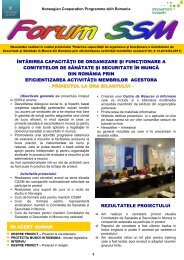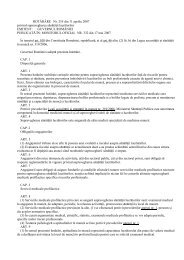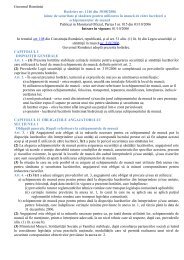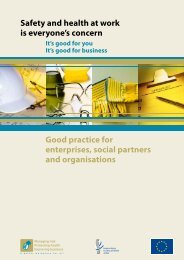Preventing work-related musculoskeletal disorders - European ...
Preventing work-related musculoskeletal disorders - European ...
Preventing work-related musculoskeletal disorders - European ...
Create successful ePaper yourself
Turn your PDF publications into a flip-book with our unique Google optimized e-Paper software.
<strong>Preventing</strong> <strong>work</strong>-<strong>related</strong> <strong>musculoskeletal</strong> <strong>disorders</strong><br />
interventions are another important part of secondary prevention.<br />
These interventions may include medication, exercise therapy,...<br />
Regarding the effectiveness of prevention strategies, there are<br />
dissenting views in the literature. The discrepancies are often<br />
attributed to the different methodological quality of the studies: lack<br />
of control groups, lack of randomisation, lack of a placebo group,<br />
small number of subjects, no standardisation of the environment,<br />
Other negative factors are high costs of interventions, lack of<br />
underlying commitment from <strong>work</strong>ers or management.<br />
RESEARCH TOPICS/PRIORITIES<br />
Although we have already amassed valuable information and<br />
identified some consistent patterns from current research, additional<br />
research is necessary to provide a better understanding of the<br />
processes involved. The focus should be on several topics: risk factors,<br />
health outcome, exposure measurement, health surveillance and<br />
intervention. The National Research Council (1999) mentions five<br />
inter<strong>related</strong> and fundamental issues that deserve attention:<br />
• develop further models and mechanisms to investigate how<br />
tissue responds to repetitive loading, what triggers inflammatory<br />
responses and how are these influenced by individual factors?<br />
• clarify the relationships between symptoms, injury reporting,<br />
impairment and disability and how are these relationships<br />
influenced by social, legal and environmental factors. Multiple<br />
factors have to be considered.<br />
• know more about the relationships between incremental changes<br />
of the environmental load and incremental responses to define<br />
more efficient and better-targeted interventions.<br />
• have more standardisation and greater detail in injury reports,<br />
better measurements of contributors and risks, and better<br />
measurements of outcomes and other relevant variables.<br />
• have a better understanding of the clinical courses of the<br />
<strong>disorders</strong> to assist strategies for tertiary prevention.<br />
KEY REFERENCES<br />
1 <strong>European</strong> Agency for Safety and Health at Work 1999. Work-<strong>related</strong> neck and<br />
upper limb <strong>musculoskeletal</strong> <strong>disorders</strong>. Buckle P, Devereux J.<br />
2 <strong>European</strong> Agency for Safety and Health at Work 2000. Work-<strong>related</strong> low back<br />
<strong>disorders</strong>. Op De Beeck R, Hermans V.<br />
3 Hagberg M, Silverstein BA, Wells RV, Smith MJ, Hendrick HW, Carayon P, Pérusse<br />
M. Work <strong>related</strong> <strong>musculoskeletal</strong> <strong>disorders</strong>: a reference for prevention; Kuorinka I. &<br />
Forcier L (eds). London:Taylor & Francis, 1995.<br />
4 National Research Council. Work-<strong>related</strong> <strong>musculoskeletal</strong> <strong>disorders</strong>: report,<br />
<strong>work</strong>shop summary, and <strong>work</strong>shop papers. Washington DC: National Research<br />
Council, 1999.<br />
5 Wilson JR, Corlett EN. (eds). Evaluation of human <strong>work</strong> : a practical ergonomics<br />
methodology, Taylor & Francis : London, 1134 p.<br />
<strong>European</strong> Agency for Safety and Health at Work<br />
13








